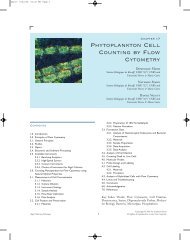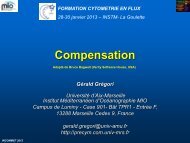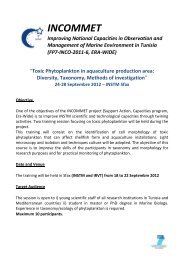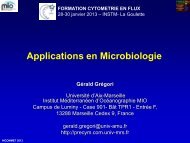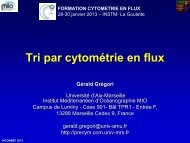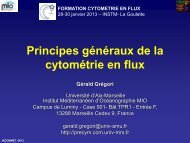Eukaryotic Picoplankton in Surface Oceans - incommet
Eukaryotic Picoplankton in Surface Oceans - incommet
Eukaryotic Picoplankton in Surface Oceans - incommet
You also want an ePaper? Increase the reach of your titles
YUMPU automatically turns print PDFs into web optimized ePapers that Google loves.
Annu. Rev. Microbiol. 2011.65:91-110. Downloaded from www.annualreviews.org<br />
by CSIC - Consejo Superior de Investigaciones Cientificas on 09/27/11. For personal use only.<br />
correlat<strong>in</strong>g abundance with environmental features<br />
or by perform<strong>in</strong>g experiments. For <strong>in</strong>stance,<br />
the bacterivorous MAST-4 exhibits<br />
trophic specialization with respect to other<br />
MAST (57). Moreover, it is absent <strong>in</strong> polar regions,<br />
so cold temperatures might set a limit<br />
to their ecological success. Similar functional<br />
surveys evaluate other picoeukaryotes, such as<br />
pras<strong>in</strong>ophytes (16, 51, 68, 86) or picohaptophytes<br />
(18, 36, 49). Another important question<br />
is whether the five MAST-4 clades are<br />
functionally redundant, or whether they exhibit<br />
slight ecological differences <strong>in</strong> their temperature<br />
optima, food spectra, or viral susceptibility.<br />
A ma<strong>in</strong> challenge <strong>in</strong> microbial ecology is determ<strong>in</strong><strong>in</strong>g<br />
the diversity level needed to expla<strong>in</strong><br />
ecosystem function<strong>in</strong>g.<br />
Community Structure<br />
<strong>Oceans</strong>, sometimes perceived as homogeneous<br />
systems, are composed of dist<strong>in</strong>ct water masses<br />
that move at different spatial and temporal<br />
scales and experience additional external forc<strong>in</strong>g<br />
(nutrient <strong>in</strong>puts, mix<strong>in</strong>g). Picoeukaryote<br />
communities are similar <strong>in</strong> sites with similar<br />
oceanographic properties (albeit distant),<br />
whereas they change across oceanographic barriers<br />
(32). In a given site, sharp vertical stratification<br />
and temporal changes are the norm.<br />
These studies are limited by sampl<strong>in</strong>g oceans at<br />
relevant scales, s<strong>in</strong>ce cruises cover only a snapshot<br />
of spatial and temporal variability. Another<br />
limitation is that the f<strong>in</strong>gerpr<strong>in</strong>t<strong>in</strong>g techniques<br />
typically used recover only the most abundant<br />
taxa, a concern that will soon be solved by<br />
high-throughput sequenc<strong>in</strong>g. Further, metagenomics<br />
would allow researchers to go beyond<br />
the s<strong>in</strong>gle-gene approach and would provide<br />
picoeukaryote functional profiles for comparative<br />
purposes.<br />
Microbial surveys show rank abundance<br />
curves characterized by a few abundant and<br />
many rare taxa, follow<strong>in</strong>g a well-known community<br />
ecology pattern (52). The long tail of<br />
rare taxa <strong>in</strong> molecular microbial surveys, perhaps<br />
larger than that <strong>in</strong> macroorganism studies,<br />
has been named rare biosphere and expla<strong>in</strong>ed<br />
by comb<strong>in</strong><strong>in</strong>g evolutionary (high dispersal<br />
and low ext<strong>in</strong>ction rates) and ecological<br />
(feast and fam<strong>in</strong>e survival) forces. The rare biosphere<br />
could be regarded as a seed bank of less<br />
competitive functionally redundant microbes,<br />
which may provide an <strong>in</strong>surance to ma<strong>in</strong>ta<strong>in</strong><br />
biogeochemical processes <strong>in</strong> the face of ecosystem<br />
change (10). However, this view derives<br />
from prokaryote studies and it is not clear if<br />
eukaryotes have similar survival strategies. A<br />
deeper sequenc<strong>in</strong>g effort (together with careful<br />
phylogenetic analysis) is required to determ<strong>in</strong>e<br />
the extent of the protist rare biosphere.<br />
Many ecologists claim that a system cannot<br />
be understood by study<strong>in</strong>g the parts separately<br />
and then putt<strong>in</strong>g them together, s<strong>in</strong>ce important<br />
emerg<strong>in</strong>g properties appear only with an<br />
<strong>in</strong>tegral study of the system (48). This bulk approach<br />
has been foundational <strong>in</strong> microbial ecology,<br />
by first treat<strong>in</strong>g all microbes <strong>in</strong> a black box<br />
and then open<strong>in</strong>g this s<strong>in</strong>gle box <strong>in</strong>to smaller<br />
ones. Recogniz<strong>in</strong>g the success of this approach,<br />
microbial ecologists are also tak<strong>in</strong>g the <strong>in</strong>verse<br />
path, study<strong>in</strong>g populations <strong>in</strong> detail to l<strong>in</strong>k<br />
critical functions (<strong>in</strong>clud<strong>in</strong>g novel mechanisms)<br />
to given taxa and to obta<strong>in</strong> better physiological<br />
models. Comb<strong>in</strong><strong>in</strong>g both approaches will<br />
surely provide better <strong>in</strong>sights <strong>in</strong>to the evolutionary<br />
and ecological significance of mar<strong>in</strong>e<br />
picoeukaryotes.<br />
Rare biosphere:<br />
collection of a huge<br />
number of low<br />
abundant taxa that<br />
characterize microbial<br />
communities when<br />
studied by molecular<br />
surveys<br />
SUMMARY POINTS<br />
1. Picoeukaryotes <strong>in</strong>clude phototrophic and heterotrophic protists 1–3 μm <strong>in</strong> size populat<strong>in</strong>g<br />
surface oceans everywhere, with an estimated global abundance of 10 26 cells. They<br />
contribute significantly to primary production, bacterivory, and parasitism.<br />
www.annualreviews.org • Mar<strong>in</strong>e Picoeukaryotes 105



